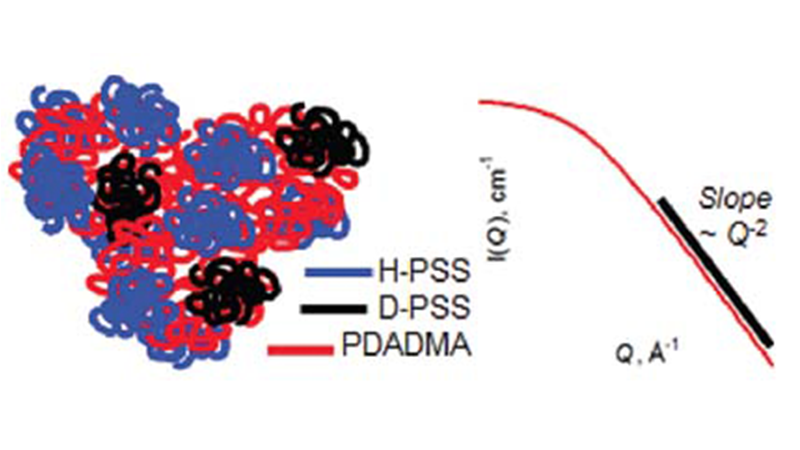Researchers at the Bio-SANS instrument at the High Flux Isotope Reactor (HFIR) used small-angle neutron scattering (SANS) to get a first insight into the conformation of single polyelectrolyte chains in large pieces of the synthetic complex. The research pursues applications for replacement of intervertebral discs in the spine and of knee cartilage.
The results present a first insight into the conformation of single polyelectrolyte chains inside synthetic complexes at the macroscopic scale, prepared by polyelectrolyte solution mixing. The results can be extrapolated to polyelectrolyte thin films made at the microscale (millionths of a meter) and at the nanoscale (billionths).
A polyelectrolyte is a long, highly charged molecule which dissolves in water. In solutions with low salt concentration, the molecules tend to be stretched out. As the salt concentration increases, the polyelectrolyte shrinks into a compact coil. The shape of the polyelectrolyte can be seen with neutron scattering.
The unique properties of these materials, already used extensively in personal care products like shampoo, are being exploited in a wide range of technological and industrial fields. Polyelectrolyte complexes are of intense interest for making membranes, 3-dimensional bioscaffolds to grow cells for regenerating skin, muscle, and even organs, and as substrates for multiple cell growth applications.
Researchers at Florida State University (FSU) have discovered that polyelectrolyte complexes have properties similar to cartilage. They are pursuing applications for replacement of intervertebral discs in the spine and in knee cartilage. These applications depend on matching the mechanical properties of the polyelectrolyte complexes as closely as possible to the natural materials they are replacing. Knowing whether the individual polyelectrolyte chains are stretched or coiled would help predict the mechanical properties of the complexes.
The FSU team has partnered with the Center for Structural Molecular Biology and the Bio-SANS instrument team at the High Flux Isotope Reactor, both at ORNL, to study the shape of polyelectrolyte chains inside samples of some of the complexes. The researchers labeled polymer chains with deuterium, a heavy isotope of hydrogen, to get good neutron contrast for the SANS instrument. This enabled them to see, for the first time, the shape of chains inside the complex. Neutron scattering revealed that the single polymer molecules form as compact coils rather than as extended strings. They hope to use this information to develop a whole new series of biotechnological devices.
The researchers blended two oppositely charged polyelectrolytes: polystyrene sulfonate (PSS) as the (negatively charged) polyanion and poly(diallyldimethylammonium chloride (PDADMA) as the (positively charged) polycation. They mixed these at optimized polyelectrolyte and NaCl concentrations. The resulting complexes are stoichiometric; i.e., every positive charge in the complex was matched with a negative charge.
The samples were placed in an ultracentrifuge, followed by temperature and salt annealing, to provide porous yet homogenous material for SANS characterization. Bio-SANS, with contrast matching, was then used to study the single polyanion chain dimensions in the compounds.
The SANS curves (see diagram) indicate that the polyelectrolyte chains in the complexes were well coiled, regardless of molecular weight. The PSS coils were slightly larger for higher molecular weight material.
The researchers observed slight variations from ideality for large and small chains. They concluded that some of the oppositely charged polymers pair like ladders. This pairing stiffens the chains and expands them.
At high salt concentrations, the researchers observed two competing factors: chain swelling due to the hydrating effects of the doping ions and chain collapse due to the decoupling of PSS from PDADMA units, especially ladder-type interactions.
This research was funded by the U.S. Department of Energy Office of Basic Energy Sciences.
Published Work
:
M. Z. Markarian, H. H. Hariri, A. Reisch, V. S. Urban, and J. B. Schlenoff, “A Small-Angle Neutron Scattering Study of the Equilibrium Conformation of Polyelectrolytes in Stoichiometric Saloplastic Polyelectrolyte Complexes,” Macromolecules 24(2), 1016-1024 (2012). DOI: http://dx.doi.org/10.1021/ma2022666.





